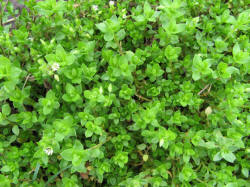|
Snow,
weeds and nuisance fruit
By John
Fulton
 Send a link to a friend
Send a link to a friend
[March
30, 2009]
We are now on the books with the first snow of
spring. Two to 4 inches of the white stuff, but at least it didn't
last long. We really won't have any ill effects to plants from the
snow; quite the contrary, as it provided an insulating blanket for
everything. Grass and early garden plants look better after the snow
than two days ago. Of course we can do without any more for this
season. The main problem is the moisture accompanying the storm.
Soil will be too wet to work for several days now, and this fact can
put us a little behind on the gardening calendar. Don't worry,
unless the trend is prolonged. Heat units accelerate as we approach
the summer months, and many crops catch up quickly.
|
 Winter annual weeds Winter annual weedsEach year, the winter annual weeds
chickweed and henbit run No. 1 and 2 in the early spring. This
year is seems like henbit is running slightly ahead. Winter
annual weeds can actually germinate in the fall, carry through
the winter, then get going very early in the spring. They also
are done by the heat of the summer, leaving seed to germinate
again later in the fall.

Right now chickweed stands out in yards because it is quite
abundant and has a lighter green color than grass and most other
weeds. I can't begin to tell you how to identify it; it gets
even harder when there is common chickweed and mouse-ear
chickweed.

Henbit is easier to identify since it has purple
flowers and smells like mint.
As for control, that gets a bit easier. The straight 2,4-D
that is used on dandelions seems to act like a fertilizer for
chickweed and other problem weeds. Combinations that contain
2,4-D, MCPP and dicamba are rated very effective on chickweed,
henbit, red sorrel, purslane, white clover and others. Just
remember the control time for most broadleaf weeds is early May.
These combinations are sold under several different trade names.
You can find these at most hardware, discount, and lawn and
garden stores. Just check the label under active ingredients and
check for two long chemical names and dicamba. You can also
check to see that it says it will control chickweed and henbit.
This group of chemicals is effective in the 50-degree range and
up.
As with any chemical control, read and follow label
instructions very carefully. You should be aware of some
cautions on these product labels concerning injury to sensitive
plants. This is because dicamba can drift as a vapor for a few
weeks after you apply it, if the weather gets hot and sunny.
[to top of second column] |

Nuisance fruit prevention
One of the main things to discuss today is the removal of
nuisance fruit. You may be thinking about those apples or peaches,
but really the nuisance fruit category includes things that are much
more a nuisance, like sweet gum balls, maple seeds and crab apples.
There are several products available to eliminate nuisance fruit.
The most common is ethephon, and it is used as a foliar spray to
reduce or eliminate undesirable fruit or seeds. A couple of the
trade names are Florel and Ethrel. The product is effective at
eliminating much of the fruit without affecting leaf growth and
color, and it does not harm other plants that get some spray drift
on them. It also does not affect the actual flowering of the treated
trees.
With ethephon, the key is in the timing. The application must be
made during flowering but before the fruit set in. For most
flowering trees there is a 10- to 14-day window of opportunity.
Sweet gums are a little tricky since there are no showy flowers
involved, so effective sprays should occur just as new leaves begin
to emerge. Sprays should leave leaves wet, but not to the point of
dripping. Good coverage of the tree is needed, so keep in mind the
size of the tree when you are weighing this option. There are
injectable products available, but they must be applied by a
professional. The injectable products have not been as effective as
the sprays.
This product is a growth regulator that naturally occurs. Its
natural production is stimulated by stress, so make sure you aren't
treating a tree that is under stress from drought, high
temperatures, diseases or other environmental stresses. Treating
stressed trees can cause severe injury to the plant, such as leaf
loss or scorching.
[By
JOHN FULTON,
University of Illinois Extension, Logan County]
 |